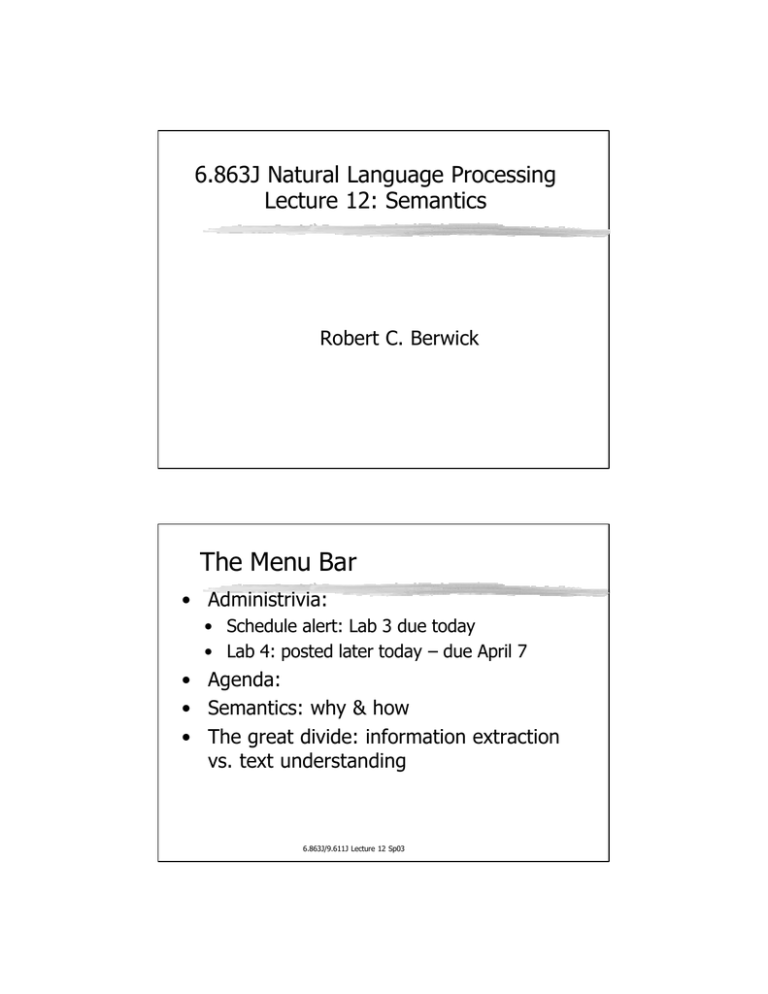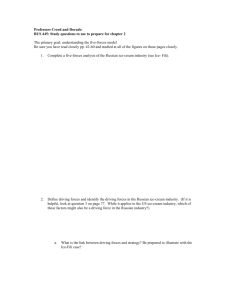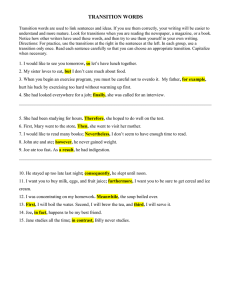Document 13545913
advertisement

6.863J Natural Language Processing
Lecture 12: Semantics
Robert C. Berwick
The Menu Bar
• Administrivia:
• Schedule alert: Lab 3 due today
• Lab 4: posted later today – due April 7
• Agenda:
• Semantics: why & how
• The great divide: information extraction
vs. text understanding
6.863J/9.611J Lecture 12 Sp03
Example of what we might do: text understanding via q-answering
athena>(top-level)
Shall I clear the database? (y or n) y
sem-interpret>John saw Mary in the park
OK.
sem-interpret>Where did John see Mary
IN THE PARK.
sem-interpret>John gave Fido to Mary
OK.
sem-interpret>Who gave John Fido
I DON'T KNOW
sem-interpret>Who gave Mary Fido
JOHN
sem-interpret >John saw Fido
OK.
sem-interpret>Who did John see
FIDO AND MARY
6.863J/9.611J Lecture 12 Sp03
How: recover meaning from
structure
S or IP VP(NP )= ate (john ,icecream)
john
VP= ly.ate (y, ice-cream)
NP
John
V
lxly.ate (y, x)
ate
6.863J/9.611J Lecture 12 Sp03
NP ice-cream
ice-cream
“Logical” semantic interpretation
•
Four basic principles
1. Rule-to-Rule semantic interpretation [aka “syntax­
directed translation”]: pair syntax, semantic rules. (GPSG:
pair each cf rule w/ semantic ‘action’; as in compiler theory
– due to Knuth, 1968)
2. Compositionality: Meaning of a phrase is a function of
the meaning of its parts and nothing more e.g., meaning of
SfiNP VP is f(M(NP)• M(VP)) (analog of ‘context-freeness’
for semantics – local)
3. Truth conditional meaning: meaning of S equated with
conditions that make it true
4. Model theoretic semantics: correlation betw. Language
& world via set theory & mappings
6.863J/9.611J Lecture 12 Sp03
Answer 1: translation – from ‘syntactic’
rep to ‘semantic’ rep, aka “Deep”
• Mirrors the progamming language approach
• When is it used?
• DB Q&A (but answer 2 can be used here…when
and how?)
• Text understanding: when all the text is
relevant - voice, inference, paraphrase,
important
• Intentions, beliefs, desires (non-extensional=
not just sets of items)
6.863J/9.611J Lecture 12 Sp03
Answer 2 – ‘Shallow’ –
information extraction
• What do we need to know to get this task done?
• Slot-and-filler semantics
• Limited parsing, limited predicate-
arguments
• Let’s see what we need to know about ‘meaning’ by looking at an example
6.863J/9.611J Lecture 12 Sp03
Example – news stories/MUC
Bridgestone Sports Co. said Friday it has set up a joint venture in Taiwan with a local concern and a
Japanese trading house to produce golf clubs to be shipped to Japan. The joint venture , Bridgestone
Sports Taiwan Co., capitalized at 20 million new Taiwan dollars, will start production in January 1990
with production of 20,000 iron and "metal wood" clubs a month.
TIE-UP-1:
Relationship:
Entities:
TIE-UP
"Bridgestone Sports Co."
"a local concern“
"a Japanese trading house"
Joint Venture Company: "Bridgestone Sports Taiwan Co." Activity:
ACTIVITY-1 Amount:
NT$20000000 ACTIVITY-1: Activity:
Company:
Product:
Start Date:
PRODUCTION "Bridgestone Sports Taiwan Co." "iron and `metal wood' clubs" DURING: January 1990 6.863J/9.611J Lecture 12 Sp03
Vs. this task…
Person: Put the blue block on the pyramid
System: I’m going to have to clear off the
pyramid. Oops, I can’t do that – a
pyramid can’t support the block.
OK, move it onto the red block.
OK.
What supports the blue block?
The red block.
6.863J/9.611J Lecture 12 Sp03
Key questions
• What do we have to know in order to get
the job done?
• And then – how do we represent this
knowledge?
• And then – how do we compute with this
representation?
• (cf. David Marr’s notions)
6.863J/9.611J Lecture 12 Sp03
Answers defined in terms of characteristics
of ‘the task’
• Information extraction
• Function is communication of factual information
• Typically only parts of the text are relevant
• Typically only part of a relevant sentence is
relevant
• Only predicate-argument structure needed (at
a superficial level)
• No modeling of author or audience
6.863J/9.611J Lecture 12 Sp03
‘Shallow’ or IE task
• Predicate-arguments: ‘who did what to
whom’ – in fact, just a core set of verbs
that are relevant (e.g., if business merger,
‘set up’, ‘produce’,… etc.)
• Extract simple relationships among
singular entities
• E.g., `X set up a joint-venture with Y’
6.863J/9.611J Lecture 12 Sp03
Example – news stories/MUC
Bridgestone Sports Co. said Friday it has set up a joint venture in Taiwan with a local concern and a
Japanese trading house to produce golf clubs to be shipped to Japan. The joint venture , Bridgestone
Sports Taiwan Co., capitalized at 20 million new Taiwan dollars, will start production in January 1990
with production of 20,000 iron and "metal wood" clubs a month.
TIE-UP-1:
Relationship:
Entities:
TIE-UP
"Bridgestone Sports Co."
"a local concern“
"a Japanese trading house"
Joint Venture Company: "Bridgestone Sports Taiwan Co." Activity:
ACTIVITY-1 Amount:
NT$20000000 ACTIVITY-1: Activity:
Company:
Product:
Start Date:
PRODUCTION "Bridgestone Sports Taiwan Co." "iron and `metal wood' clubs" DURING: January 1990 6.863J/9.611J Lecture 12 Sp03
Even the parsing is shallow
• Chunking – no recursion, just p.o.s
brackets
• [Bridgestone Sports Co.][said [Friday] ] [it ] has [ set up [ a joint
venture ] ] in Taiwan with a local concern and a Japanese trading
house to produce golf clubs to be shipped to Japan. The joint venture,
Bridgestone Sports Taiwan
Can use simple linear patterns:
chunk: NP -> D? N+;
VP -> V-tns | Aux V-ing
clause: S -> PP* NP PP* VP PP*
6.863J/9.611J Lecture 12 Sp03
What we give up – in terms of
‘big picture’
PP, adv
attachment
quantifiers
pred-args
Tense, time
Tag,parse
wordsfi morph
modals
Non-literal
meaning
indirect speech
act
Direct speech
act
6.863J/9.611J Lecture 12 Sp03
IE or Shallow
• Parsing:
• PP attachment – ignored, except for arguments of
domain relevant verbs
“set up a joint venture” vs. “a joint venture in Japan” vs. “a
joint venture in their home office”
• Adverbials – only locatives, temporal adverbs; others
ignored (why?)
• Semantics:
• No modals (might, will, could…)
• No propositional attitudes, possible worlds, user
intentions, etc. (believe, want, unicorns,…)
• Non-literal meaning
6.863J/9.611J Lecture 12 Sp03
What’s all this stuff that’s added?
• Parsing
• Details of all phrase attachments - exact
• Logical Semantic additions:
•
•
•
•
•
•
•
All arguments to all predicate-argument structure
Adjunct modifiers
Quantifiers
Detailed, accurate tense representation
Modal verbs
Propositional attitudes, belief contexts
Direct and indirect speech acts
6.863J/9.611J Lecture 12 Sp03
What’s all this stuff??
• Quantifiers
• John ate an ice-cream
• Ice-cream now not a constant
• John ate an ice-cream and Mary ate an icecream
• In the set of ice-creams, there exists one
eaten by John
• Ice-cream a predicate on entities
• Can compute using sets (extensional)
6.863J/9.611J Lecture 12 Sp03
What’s all this stuff?
• Tense
• “There was an event some time in the past
such that an ice-cream was among the
objects eaten by John at that time”
• Could just use a variable t
• We will improve this representation later
• Why stop there? Events have other
properties
6.863J/9.611J Lecture 12 Sp03
This gets complex
• John ate an ice-cream in a booth
• Event representation
• $e past(e), act(e,eating), eater(e,John),
exists(ice-cream, eatee(e)), exists(booth,
location(e))
• John ate an ice-cream in every booth
• $e past(e), act(e,eating), eater(e,John),
exists(ice-cream, eatee(e)), all(booth, location(e)),
$g ice-cream(g), eatee(e,g)
6.863J/9.611J Lecture 12 Sp03
"b booth(b)�location(e,b)
So this means..
• This means $e "b which means same event for every
booth
• False unless John can be in every booth during his
eating of a single ice-cream
• Which order do we want?
• $b "e: “for all booths b, there was such an event in b”
• Figuring this out requires a notion of scope (and so,
structure…)
• But wait, there’s more… what about all, none, …
6.863J/9.611J Lecture 12 Sp03
Beliefs, Desires and Intentions
• How do we represent internal speaker states
like believing, knowing, wanting, assuming,
imagining..?
• Not well modeled by a simple DB lookup approach
• Truth in the world vs. truth in some possible world
George imagined that he could dance.
Geroge believed that he could dance.
• Augment FOPC with special modal operators
that take logical formulae as arguments, e.g.
believe, know
6.863J/9.611J Lecture 12 Sp03
Intensional Arguments
• John wants a unicorn (cf., John wants an ice-cream)
•
•
•
•
“there is a unicorn u that Willy wants ”
here the wantee is an individual entity
“Willy wants any entity u that satisfies the unicorn predicate”
here the wantee is a type of entity
• Problem
•
•
•
•
•
‘unicorn’ is defined by the set of unicorns – its extension
BUT this set is empty
All empty sets are equal (but some are more equal than others…)
So, John wants a unicorn ” John wants a dodo
What’s wanted (wantee) should be intension or criteria for being a
unicorn
• (One) solution: possible world semantics:
• Can imagine other worlds where set of unicorn „ set of dodos
6.863J/9.611J Lecture 12 Sp03
• Mutual belief: I believe you believe I
believe….
• Practical importance: modeling belief in
dialogue
6.863J/9.611J Lecture 12 Sp03
Non-literal meaning (source of 60% of old Star Trek plots)
• Kirk: Spock, are there any Romulans in Sector
6471?
• Spock: None, captain.
• Kirk: Are you certain, Spock?
• Spock: A 100% probability, Captain
• [camera rolls] Kirk: Damn your Vulcan ears,
Spock, I thought you said there were no
Vulcans in sector 6471!!&*(!&
• Spock: But there is no sector 6471…Logic
dictates… [Fadeout to commercial]
6.863J/9.611J Lecture 12 Sp03
What we give up – in terms of
‘big picture’
PP, adv
attachment
quantifiers
pred-args
Tense, time
Tag,parse
wordsfi morph
modals
Non-literal
meaning
6.863J/9.611J Lecture 12 Sp03
indirect speech
act
Direct speech
act
Illustrations – indirect speech act
• It’s cold in here
• What would ‘shallow approach’ do?
• What about ‘full understanding’ – indirect
speech act
• What about discourse:
• Guiliani left Bloomberg to be mayor of a
city with a big budget problem. It’s
unclear how he’ll be able to handle it
during his term.
6.863J/9.611J Lecture 12 Sp03
Why lunch at Lobdell is slow
“Do you have the salt” fi “Please pass the
salt”
6.863J/9.611J Lecture 12 Sp03
Some complications
• Temporal logic
• Gilly had swallowed eight goldfish
before Milly reached the bowl
• Billy said my pet fish was pregnant
• Billy said, “my pet fish is pregnant.”
• Generics
• Typhoons arise in the Pacific
• Children must be carried
• Presuppositions
• The king of France is bald.
• Pronoun-Quantifier Interaction (“bound anaphora”)
•
•
•
•
Every farmer who owns a donkey beats it.
If you have a dime, put it in the meter.
The woman who every Englishman loves is his mother.
I love my mother and so does Billy.
6.863J/9.611J Lecture 12 Sp03
•
Classical (logical) semantic interpretation
Four basic principles
1. Rule-to-Rule semantic interpretation [aka “syntax­
directed translation”]: pair syntax, semantic rules. (GPSG:
pair each cf rule w/ semantic ‘action’; as in compiler theory
– due to Knuth, 1968)
2. Compositionality: Meaning of a phrase is a function of
the meaning of its parts and nothing more e.g., meaning of
SfiNP VP is f(M(NP)• M(VP)) (analog of ‘context-freeness’
for semantics – local)
3. Truth conditional meaning: meaning of S equated with
conditions that make it true
4. Model theoretic semantics: correlation betw. Language
& world via set theory & mappings (extensional)
6.863J/9.611J Lecture 12 Sp03
Components
• Semantic representation (“logical form”)
• Start w/ lambda calculus, predicates
• Patch as we encounter phenomena in
language: quantifiers,
6.863J/9.611J Lecture 12 Sp03
(a)
Planner
big picture
(b)
semantic restrictions Yes-No
object actions
Inference/Model
Planner
Syntax -directed
Inference/Model
message con­
of Intentions
struction
(type hierarchy)
of Intentions
(type hierarchy)
Thematic
message phrase lists
semantic restrictions Yes-No
Syntax -directed
message con­
struction
Thematic role
selectional restrictions Yes-No
frames
Thematic
role interpreter
Syntactic structures
PP Attachment decisions YesNo
parser
6.863J/9.611J Lecture 12 Sp03
role interpreter
s parser
How: recover meaning from
structure
S or IP VP(NP )= ate (john ,icecream)
john
VP= ly.ate (y, ice-cream)
NP
John
V
lxly.ate (y, x)
ate
NP ice-cream
ice-cream
6.863J/9.611J Lecture 12 Sp03
What Counts as Understanding?
some notions
• We understand if we can respond appropriately
•
•
•
•
•
•
ok for commands, questions (these demand response)
“Computer, warp speed 5”
“throw axe at dwarf”
“put all of my blocks in the red box”
imperative programming languages
database queries and other questions
• We understand statement if we can determine its
truth
• ok, but if you knew whether it was true, why did
anyone bother telling it to you?
• comparable notion for understanding NP is to compute
what the NP6.863J/9.611J
refers Lecture
to, which
might be useful
12 Sp03
Representing Meaning
• What requirements do we have for
meaning representations?
6.863J/9.611J Lecture 12 Sp03
What requirements must meaning representations fulfill?
• Verifiability: The system should allow us to
compare representations to facts in a
Knowledge Base (KB)
• Cat(Huey)
• Ambiguity: The system should allow us to
represent meanings unambiguously
• German teachers has 2 representations
• Vagueness: The system should allow us to
represent vagueness
• He lives somewhere in the south of France.
6.863J/9.611J Lecture 12 Sp03
Requirements: Inference
• Draw valid conclusions based on the
meaning representation of inputs and its
store of background knowledge.
Does Huey eat kibble?
thing(kibble)
Eat(Huey,x) ^ thing(x)
6.863J/9.611J Lecture 12 Sp03
What Counts as Understanding?
• Be able to translate
•
•
•
•
•
Depends on target language
English to English?
bah humbug!
English to French?
reasonable
English to Chinese?
requires deeper understanding
English to logic?
deepest
all humans are mortal
=
"x [human(x) �mortal(x)]
• Assume we have logic-manipulating rules to tell us
how to act, draw conclusions, answer questions …
6.863J/9.611J Lecture 12 Sp03
Requirements: Canonical Form
• Inputs that mean the same thing have the same
representation.
•
•
•
•
Huey eats kibble.
Kibble, Huey will eat.
What Huey eats is kibble.
It’s kibble that Huey eats.
• Alternatives
• Four different semantic representations
• Store all possible meaning representations in Knowledge Base
6.863J/9.611J Lecture 12 Sp03
Requirements: Compositionality
• Can get meaning of “brown cow” from
separate, independent meanings of
“brown” and “cow”
• Brown(x)� Cow(x)
• I’ve never seen a purple cow, I never
hope to see one…
6.863J/9.611J Lecture 12 Sp03
Barriers to compositionality
• Ce corps qui s’appelait e qui s’appelle
encore le saint empire romain n’etait en
aucune maniere ni saint, ni romain, ni
empire.
• This body, which called itself and still calls
itself the Holy Roman Empire, was neither
Holy, nor Roman, nor an Empire -Voltaire
6.863J/9.611J Lecture 12 Sp03
Need some kind of logical calculus
• Not ideal as a meaning representation and
doesn't do everything we want - but close
•
•
•
•
Supports the determination of truth
Supports compositionality of meaning
Supports question-answering (via variables)
Supports inference
• What are its elements?
• What else do we need?
6.863J/9.611J Lecture 12 Sp03
The elements
Three major kinds of objects
1. Booleans
• Roughly, the semantic values of sentences
2. Entities
• Values of NPs, i.e., objects
• Maybe also other types of entities, like times
3. Functions of various types
• A function returning a boolean is called a
“predicate” – e.g., frog(x), green(x)
• Functions might return other functions!
• Function might take other functions as
arguments!
6.863J/9.611J Lecture 12 Sp03
Syntax for this calculus
• Terms: constants, functions, variables
• Constants: objects in the world, e.g. Huey
• Functions: concepts, e.g. sisterof(Huey)
• Variables: x, e.g. sisterof(x)
• Predicates: symbols that refer to relations that
hold among objects in some domain or
properties that hold of some object in a domain
likes(Huey, kibble)
cat(Huey)
6.863J/9.611J Lecture 12 Sp03
• Logical connectives permit compositionality of
meaning
kibble(x) fi likes(Huey,x)
cat(Vera) ^ weird(Vera)
sleeping(Huey) v eating(Huey)
• Expressions can be assigned truth values, T
or F, based on whether the propositions they
represent are T or F in the world
• Atomic formulae are T or F based on their presence or absence in a DB (Closed World Assumption?)
• Composed meanings are inferred from DB and meaning of logical connectives
6.863J/9.611J Lecture 12 Sp03
•
•
•
•
cat(Huey)
sibling(Huey,Vera)
sibling(x,y) ^ cat(x) fi cat(y)
cat(Vera)??
• Limitations:
• Do ‘and’ and ‘or’ in natural language really
mean ‘^’ and ‘v’? Mary got married and had a baby.
Your money or your life!
He was happy but ignorant.
• Does ‘fi’ mean ‘if’? I’ll go if you promise to wear a tutu.
6.863J/9.611J Lecture 12 Sp03
What Can Serve as a Meaning Representation?
• Anything that serves the core practical purposes
of a program that is doing semantic processing
...
• Answer questions (What is the tallest building in the
world?)
• Determining truth (Is the blue block on the red
block?)
• Drawing inferences (If the blue block is on the red
block and the red block is on the tallest building in
the world, then the blue block is on the tallest
building in the world)
6.863J/9.611J Lecture 12 Sp03
Common Meaning
Representations
• First order predicate calculus (FOPC):
$x, yHaving( x) � Haver(S , x) � HadThing ( y, x) � Car( y)
• Semantic Net:
having
haver
had-thing
car
speaker
• Conceptual Dependency Diagram:
Car
� Poss-By
Speaker
6.863J/9.611J Lecture 12 Sp03
• Frame
Having
Haver: S
HadThing: Car
• All represent ‘linguistic meaning’ of I
have a car
and state of affairs in some world
• All consist of structures, composed of
symbols representing objects and
relations among them
6.863J/9.611J Lecture 12 Sp03
Expressiveness
• Must accommodate wide variety of
meanings
6.863J/9.611J Lecture 12 Sp03
Predicate-Argument Structure
• Represents concepts and relationships among
them
• Nouns as concepts or arguments (red(ball))
• Adjectives, adverbs, verbs as predicates (red(ball))
• Subcategorization (or, argument) frames
specify number, position, and syntactic
category of arguments
• NP likes NP
• NP likes [to eat ice-cream]
6.863J/9.611J Lecture 12 Sp03
Thematic Roles
• Subcat frames link arguments in surface
structure with their semantic roles
• Agent: George hit Bill. Bill was hit by George.
• Patient: George hit Bill. Bill was hit by George.
• Selectional Restrictions: constraints on the
types
of arguments verbs take
George assassinated the senator.
*The spider assassinated the fly.
assassinate: intentional (political?) killing
6.863J/9.611J Lecture 12 Sp03
What
• What representation do we want for
something like
John ate ice-cream fi
ate(John, ice-cream)
• Lambda calculus
• We’ll have to posit something that will do
the work
• Predicate of 2 arguments:
lx ly ate(y, x)
6.863J/9.611J Lecture 12 Sp03
What: Basic semantic representation:
or ‘thematic role’ frame
• Use of “Event structure” (recursive)
(EVENT :condition1 val1 :condition2 val2…
:condn valn)
Example:
• (see :agent John :patient Mary :tense past)
• Sometimes called a ‘thematic role frame’ or
(earlier): ‘case frame’ (Fillmore, 1965)
6.863J/9.611J Lecture 12 Sp03
More complex example (cause :agent (bob) :effect (go :theme (book) :path
(path :oper (onto) :terminal+ (shelf))) :tense
past)
6.863J/9.611J Lecture 12 Sp03
Meaning of sentence
• Is the application of the lambda form associated
with the VP to the lambda form given by the
argument NP
• Words just return ‘themselves’ as values (from
lexicon)
• Given parse tree, then by working bottom up as
shown next, we get to the logical form
ate(John, ice-cream)
• This predicate can then be evaluated against a
database – this is model interpretation- to
return a value, or t/f, etc.
6.863J/9.611J Lecture 12 Sp03
Lambda application works
• Suppose John, ice-cream = constants,
i.e., lx.x, the identity function
• Then lambda substitution does give the
right results:
lx ly ate(y, x) (ice-cream)(John)fi
ly ate(y, ice-cream)(John)fi
ate(John, ice-cream)
But… where do we get the l-forms from?
6.863J/9.611J Lecture 12 Sp03
Example of what we now can do
athena>(top-level)
Shall I clear the database? (y or n) y
sem-interpret>John saw Mary in the park
OK.
sem-interpret>Where did John see Mary
IN THE PARK.
sem-interpret>John gave Fido to Mary
OK.
sem-interpret>Who gave John Fido
I DON'T KNOW
sem-interpret>Who gave Mary Fido
JOHN
sem-interpret >John saw Fido
OK.
sem-interpret>Who did John see
FIDO AND MARY
6.863J/9.611J Lecture 12 Sp03
How: to recover meaning from structure
S
John=
NP*
VP
lxly ate(y,x).ic=
*= V*(NP*)= ly ate(y, ic)
NP* =ice-cream
V*
John
lx.x, x=John
ate
ice-cream
lxly ate(y,x) lx.x, x=ice-cream
6.863J/9.611J Lecture 12 Sp03
How
ate(John, ic)
S *= VP*(NP*)=ly ate(y, ic).John=
ate(John, ic)
VP*=ly
John=
NP*
John
lx.x, x=John
V*
ate
ate(y, ic)
NP*=ice-cream
ice-cream
lxly ate(y,x) lx.x, x=ice-cream
6.863J/9.611J Lecture 12 Sp03
In this picture
• The meaning of a sentence is the
composition of a function VP* on an
argument NP*
• The lexical entries are l forms
• Simple nouns are just constants
• Verbs are l forms indicating their argument
structure
• Verb phrases return l functions as their
results (in fact – higher order)
6.863J/9.611J Lecture 12 Sp03
How
• Application of the lambda form associated with
the VP to the lambda form given by the
argument NP
• Words just return ‘themselves’ as values (from
lexicon)
• Given parse tree, then by working bottom up as
shown next, we get to the logical form
ate(John, ice-cream)
• This predicate can then be evaluated against a
database – this is model interpretation- to
return a value, or t/f, etc.
6.863J/9.611J Lecture 12 Sp03
Code – sample rules
Syntactic rule
Semantic rule
(root ==> s)
(lambda (s)(PROCESS-SENTENCE s))
(s ==> np vp)
(lambda (np vp)(funcall vp np)))
(vp ==> v+args)
(lambda (v+args)(lambda (subj)
(funcall v+args subj))))
(v+args ==> v2 np)(lambda (v2 np)
(lambda (subj)
(funcall v2 subj np))))
(lambda (agent beneficiary affcted-obj))
(v kiss)
(np-pro ==> name) #'identity)
6.863J/9.611J Lecture 12 Sp03
Verb arguments
The semantic interpreter
procedure
(lambda (s) (process-sentence s)
Root (ate :agent John :patient ice-cream :tense past)
S (lambda (np vp)
(funcall vp np)
John
VP (lambda (subj) (funcall v2+tns subj))
NP
(lambda(x) x)
NP-pro
V+args
NP
(lambda(v2+tns np)
Name
NP-pro
John
V2+tns NP
John
Name
(lambda(x) x)
*lexical-semantics*
John
ate
*lexical-semantics*
(lambda (subj)
(funcall v2+tns subj np))
ice-cream
ice-cream
*lexical-semantics*
ice-cream
(lambda (agent patient)(ate :agent agent :patient patient :tense past))
6.863J/9.611J Lecture 12 Sp03
How does this work?
• Top level lambda says to call procedure named VP
(whose value will be determined “from below”, ie, S-I of
VP) by using the arg NP (again whose meaning will be
provided “from below)
• In other words, to find the meaning of S, we call the
procedure VP using as an argument the subject NP
• These two values will be supplied by the (recursive)
semantic interpretation of the NP and VP nodes.
• At the very bottom, individual words must also contain
some paired ‘semantic’ value
• This is almost enough to do the code for the whole
example!
6.863J/9.611J Lecture 12 Sp03
Code – sample rules
Syntactic rule
rule
add-rule-semantics '(root ==> s)
Semantic
'(lambda (s)
(PROCESS-SENTENCE s)))
(add-rule-semantics '(s ==> np vp)
#'(lambda (np vp)
(funcall vp np)))
(add-rule-semantics '(vp ==> v+args)
#'(lambda (v+args)
#'(lambda (subj)
(funcall v+args subj))))
(add-rule-semantics '(v+args ==> v2 np)
#'(lambda (v2 np)
#'(lambda (subj)
(funcall v2 subj np))))
(add-rule-sem '(np-pro ==> name) #'identity)
6.863J/9.611J Lecture 12 Sp03
Code – the interpreter
;;Parse rules into syntactic/semantic parts, recursively
(defun phrase-semantics (phrase)
(cond ((atom (second phrase)) ; find phrase name –a word?
(word-semantics (second phrase) (first phrase))) ; o.w.
(t (rule-apply (rule-semantics (first phrase)
; recurse
(mapcar
#’first(rest phrase)))
(mapcar #'phrase-semantics
(rest phrase))))))
;; now apply-eval loop for the semantic rules
(defun rule-apply (head args)
(let ((result (apply head args)))
(if (and (consp result)
(eq (first result) 'lambda))
(eval (list 'function result))
result)))
6.863J/9.611J Lecture 12 Sp03
Code for this
(defun word-semantics (word sense)
(let ((x (lookup2 word sense *lexical-semantics*)))
(if (and (consp x)
(eq (first x) 'lambda))
(eval (list 'function x))
x)))
(defun rule-semantics (head args)
(let ((x (lookup2 head args *phrasal-semantics*)))
(if (and (consp x)
(eq (first x) 'lambda))
(eval (list 'function x))
x)))
6.863J/9.611J Lecture 12 Sp03
Construction step by step – on
NP side
root(root ==> s)(lambda (s)(PROCESS-SENTENCE s)))
s ==> np vp (lambda (np vp)(funcall vp np))
S (IP) VP(NP )= ate ( john , ice-cream)
john
john
NP-pro
VP
V+args
name
john
John
V2
NP
ate
name
-
np-pro ==> name
#'identity
Word-semantics
john
6.863J/9.611J Lecture 12 Sp03
In this picture
• The meaning of a sentence is the
composition of a function VP* on an
argument NP*
• The lexical entries are l forms
• Simple nouns are just constants
• Verbs are l forms indicating their argument
structure
• Verb phrases return a function as its
result
6.863J/9.611J Lecture 12 Sp03
Syntax & paired semantics
Item or rule
Verb ate
propN
V
Semantic translation
lxly.ate(y, x)
lx.x
V*= l for lex entry
S (or CP)
NP
VP
S*= VP*(NP*)
N*
V*(NP*)
6.863J/9.611J Lecture 12 Sp03
Logic: Lambda Terms
• Lambda terms:
• A way of writing “anonymous functions”
• No function header or function name
• But defines the key thing: behavior of the function
• Just as we can talk about 3 without naming it “x”
•
•
•
•
Let square = lp p*p
Equivalent to int square(p) { return p*p; }
But we can talk about lp p*p without naming it
Format of a lambda term: l variable expression
6.863J/9.611J Lecture 12 Sp03
Logic: Lambda Terms
• Lambda terms:
•
•
•
•
Let square = lp p*p
Then square(3) = (lp p*p)(3) = 3*3
Note: square(x) isn’t a function! It’s just the value x*x.
But lx square(x) = lx x*x = lp p*p = square
(proving that these functions are equal – and indeed they are,
as they act the same on all arguments: what is ( lx square(x))(y)? )
•
•
•
•
Let even = lp (p mod 2 == 0) a predicate: returns true/false
even(x) is true if x is even
How about even(square(x))?
lx even(square(x)) is true of numbers with even squares
• Just apply rules to get lx (even(x*x)) = lx (x*x mod 2 == 0)
• This happens to denote the same predicate as even does
6.863J/9.611J Lecture 12 Sp03
Logic: Multiple Arguments
• All lambda terms have one argument
• But we can fake multiple arguments ...
• Suppose we want to write times(5,6)
• Remember: square can be written as lx square(x)
• Similarly, times is equivalent to lx ly times(x,y)
• Claim that times(5)(6) means same as times(5,6)
• times(5) = (lx ly times(x,y)) (5) = ly times(5,y)
• If this function weren’t anonymous, what would we call it?
• times(5)(6) = (ly times(5,y))(6) = times(5,6)
6.863J/9.611J Lecture 12 Sp03
Logic: Multiple Arguments
• All lambda terms have one argument
• But we can fake multiple arguments ...
• Claim that times(5)(6) means same as times(5,6)
• times(5) = (lx ly times(x,y)) (5) = ly times(5,y)
• If this function weren’t anonymous, what would we call it?
• times(5)(6) = (ly times(5,y))(6) = times(5,6)
� So we can always get away with 1-arg functions ...
� ... which might return a function to take the next argument. Whoa.
� We’ll still allow times(x,y) as syntactic sugar, though
6.863J/9.611J Lecture 12 Sp03
Grounding out
• So what does times actually mean???
• How do we get from times(5,6) to 30 ?
• Whether times(5,6) = 30 depends on whether symbol times
actually denotes the multiplication function!
• Well, maybe times was defined as another lambda term,
so substitute to get times(5,6) = (blah blah blah)(5)(6)
• But we can’t keep doing substitutions forever!
• Eventually we have to ground out in a primitive term
• Primitive terms are bound to object code
• Maybe times(5,6) just executes a multiplication function
• What is executed by loves(john, mary) ?
6.863J/9.611J Lecture 12 Sp03
Logic: Interesting Constants
• Thus, have “constants” that name some of
the entities and functions (e.g., times):
• Eminem - an entity
• red – a predicate on entities
• holds of just the red entities: red(x) is true if x is red!
• loves – a predicate on 2 entities
• loves(Eminem,Detroit)
• Question: What does loves(Detroit) denote?
• Constants used to define meanings of words
• Meanings of phrases will be built from the
constants & syntactic structure
6.863J/9.611J Lecture 12 Sp03
How: to recover meaning from
structure
S
John=
NP*
VP
lxly ate(y,x).ic=
*= V*(NP*)= ly ate(y, ic)
V*
John
lx.x, x=John
ate
NP* =ice-cream
ice-cream
lxly ate(y,x) lx.x, x=ice-cream
6.863J/9.611J Lecture 12 Sp03
How
ate(John, ic)
S *= VP*(NP*)=ly ate(y, ic).John=
ate(John, ic)
John=
VP*=ly
NP*
John
lx.x, x=John
V*
ate
ate(y, ic)
NP*=ice-cream
ice-cream
lxly ate(y,x) lx.x, x=ice-cream
6.863J/9.611J Lecture 12 Sp03
Processing options
• Off-line vs. on-line
• Off-line: do all syntax first, then pass to
semantic interpretation (via pass on
syntax tree(s))
• On-line: do it as each phrase is completed
6.863J/9.611J Lecture 12 Sp03
On-line
S � NP VP {VP*(NP*)}
• VP* has been stored in state representing VP
• NP* stored with the state for NP
• When rule completed, go get value of VP*, go get
NP*, and apply VP* to NP*
• Store result in S*.
• As fragments of input parsed, semantic
fragments created
• Can be used to block ambiguous
representations
6.863J/9.611J Lecture 12 Sp03
Picture
event
S
Conceptual interface
NP
name
John
John
S-I
6.863J/9.611J Lecture 12 Sp03
Processing order: online
• Interpret subtree as soon as it is built –eg, as soon as
RHS of rule is finished (complete subtree)
• Picture: “ship off” subtree to semantic interpretation as
soon as it is “done” syntactically
• Allows for off-loading of syntactic short term memory;
SI returns with ‘ptr’ to the interpretation
• Natural order to doing things (if process left to right)
• Has some psychological validity – tendency to interpret
asap & lower syntactic load
• Example: I told John a ghost story vs. I told John a
ghost story was the last thing I wanted to hear
6.863J/9.611J Lecture 12 Sp03
Drawback
• You also perform semantic analysis on
orphaned constituents that play no role in
final parse
• Worst case:
• Jump out the window,
• But not before you put on your parachute
• Hence, case for pipelined approach: Do
semantics after syntactic parse
6.863J/9.611J Lecture 12 Sp03
Doing Compositional Semantics
• To incorporate semantics into grammar we must
• Figure out right representation for a single
constituent based on the parts of that constituent
(e.g. Adj)
• Figuring out the right representation for a category of
constituents based on other grammar rules making
use of that constituent (e.g NP� Adj Noun)
• This gives us a set of function-like semantic
attachments incorporated into our CFG
• E.g. NP � Adj Noun* {lx Noun*(x) ^ Isa(x,Adj*)}
6.863J/9.611J Lecture 12 Sp03
What do we do with them?
• As we did with feature structures:
• Alter an Early-style parser so when
constituents (dot at the end of the rule) are
completed, the attached semantic function
applied and meaning representation created
and stored with state
• Or, let parser run to completion and then
walk through resulting tree running
semantic attachments from bottom-up
6.863J/9.611J Lecture 12 Sp03
What can we do with this machinery?
• A lot (almost all): start adding phenomena
(figure out the representation) – and see
• To begin: wh-moved NPs (which book…),
which act just like other quantifiers
6.863J/9.611J Lecture 12 Sp03
Wh questions
• Part of process-sentence
• Wh form is placed by semantics in
template as, eg, ?which or ?who
• This will then correspond to the “for which
x, x a person” typed lambda calculus form
we wanted – explicitly in a procedural way
• Procedure prompts a search through db
for matching sets of items that can align
w/ the template
6.863J/9.611J Lecture 12 Sp03
Picture – wh-NP & trace exactly
in correct configuration
which
book/?which
book
see
x
6.863J/9.611J Lecture 12 Sp03
Summing Up
• Hypothesis: Principle of Compositionality
• Semantics of NL sentences and phrases can be
composed from the semantics of their subparts
• Rules can be derived which map syntactic
analysis to semantic representation (Rule-toRule Hypothesis)
• Lambda notation provides a way to extend FOPC to
this end
• But coming up with rule2rule mappings is hard
• Idioms, metaphors perplex the process
6.863J/9.611J Lecture 12 Sp03






